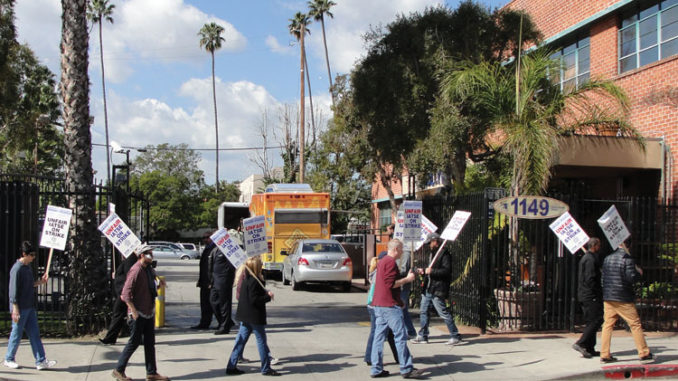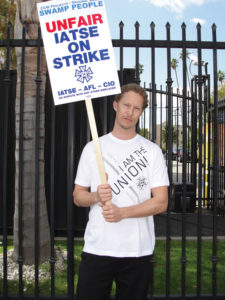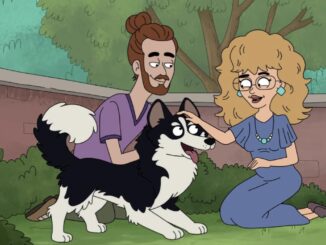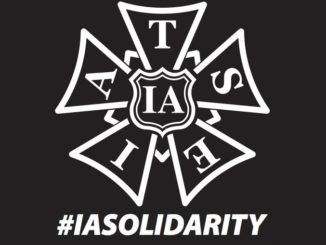
by Rob Callahan

With this issue’s column, I salute the post-production crew members of Original Media’s docu-reality program Swamp People. Their example has taught us something new about the leverage we have in post, and has reminded us of old lessons about what makes our union strong.
Unionism depends upon a simple, self-evident premise: Solidarity affords us strength. For members of Local 700, solidarity is not limited to colleagues in nearby edit bays, nor even to the 7,200 other members of the Guild. The solidarity from which we draw our strength encompasses all of our brothers and sisters working in crafts represented by the IATSE. Indeed, folks in post profit tremendously from alliances with far-flung co-workers on production crews, whom we may never have occasion to meet face to face.
In organizing, the IATSE makes effective use of recognition strikes — work stoppages aimed to unionize previously non-union employers. For much of the rest of the labor movement, recognition strikes went out of style with the advent of the Wagner Act (or National Labor Relations Act) in 1935. But in our industry, the recognition strike — or the specter of one — remains a key tactic for organizing non-union productions. IATSE recognition strikes are generally aimed at disrupting a show’s production schedule. During such actions, editors and assistants step off the job along with their counterparts on the production crew. But, in most such strikes, the majority of the employees are on the production side, and the shooting schedule determines the timing of the action.
Thus, most of the time you are working a union job, the contract you’re working under was won when a crew shut down production, or else was secured because a producer reasonably worried that a shoot might be shut down. With regards to organizing, post-production employees often ride on the shoulders of the production crew. In particular, the strategy of disrupting or threatening disruption of production has allowed for the IATSE to make great strides in recent years in securing union contracts for those working in unscripted television.
The current wave of organizing in reality TV can be traced back to the high-profile, hard-fought strike against The Biggest Loser in November of 2010. That strike represented a shameful exception to the rule of post-production participation in IATSE job actions. Most editors and assistants remained on the job during that work stoppage, thus undermining the crew’s leverage and prolonging the strike. Thankfully, the solidarity of that show’s production crew was sufficient to overcome the perfidy of its post crew, and the editorial crew’s act of betrayal is an anomaly in a history otherwise characterized by cohesion across craft lines.
The Biggest Loser was certainly not the first reality television show to organize, but the success of that campaign generated momentum, and signaled the IATSE’s recommitment to winning contracts for work in the genre. In the years since, many additional shows followed, and the IATSE also secured term agreements covering some of the biggest makers of unscripted programming, including Fremantle, Reveille (now Shine America) and, most recently, Endemol.
A company executive telephoned each member of the crew, imploring them to return to their jobs. He received the same response from each: We are eager to get back to work, but only under a union deal that returns everybody to work.
An organizing strategy focused on shows’ production schedules, though, has certain limitations. Although such an approach works well for shows with relatively large and professional production, it may not for the subgenre of run-and-gun-style docu-reality shows. Such programs employ much smaller (and oftentimes less experienced) production crews, rendering them largely immune to organizing approaches oriented towards disrupting production.
Although Swamp People employed a relatively small production crew working a relatively short shooting schedule in Louisiana, the editorial crew is large and works on the project for many months in LA. An organizing campaign structured around the work of the production crew would have faced high hurdles, but the post-production team, under a heavy workload and tight deadlines, had considerable leverage. Our organizing strategy for this show therefore inverted the usual approach; organizing in post would carry production.
Production on the show wrapped in October and, after many harried months of editorial work, the first episode of the season aired on the History Channel on February 14. Over the course of these first few months of post-production, editors and assistants discussed unionization amongst themselves, and a consensus emerged that such a successful show (it was the network’s top show and ranks high in cable ratings) ought to provide union health and retirement benefits.
On February 18, days after the season premiere, Swamp People producers visited the edit bays of several editors and interrogated them individually about their knowledge of union organizing activity. Such questioning constitutes an Unfair Labor Practice (ULP) — an illegal infringement of people’s right to organize without interference from management. In response, the union filed charges with the National Labor Relations Board and 15 editors and assistants walked off the job on the morning of February 19. The walkout immediately called into question the production’s ability to meet looming delivery dates; negotiations with the company began early that afternoon.

Among the sticking points in negotiations was Original Media’s initial insistence that any deal cover only the editorial crew on strike, leaving the show’s production crew excluded. The post crew understood that our achievements in unscripted TV have been predicated upon solidarity between production and post, and knew that the union could not accept any deal that shut out the show’s shooting crew from future coverage.
Negotiations stretched out for several days while the post crew, bolstered by volunteers from Local 700 and our sister locals in the IATSE, walked the picket line. On February 21, a company executive telephoned each member of the crew, imploring them to return to their jobs. He received the same response from each: We are eager to get back to work, but only under a union deal that returns everybody to work.
By the morning of February 22, an agreement was reached. The editorial crew would go back to work under the provisions of the Videotape Agreement. Editors and assistants would receive health and pension benefits paid retroactively back to their dates of hire on the season — which amounted to up to six months of contributions for the longest-serving employees. The company agreed that it would negotiate terms and conditions of employment for production employees in advance of the resumption of production for next season. The crew’s conviction and tenacity was rewarded. They won.
Hopefully, the example of Swamp People will encourage the post crews of other non-union shows to recognize the degree to which producers rely upon their work, and the amount of power they have when everyone performing that work stands united. After years of editorial employees being carried along atop the shoulders of our colleagues in other departments, we have demonstrated that our shoulders can be broad and strong enough to lift others with us.






